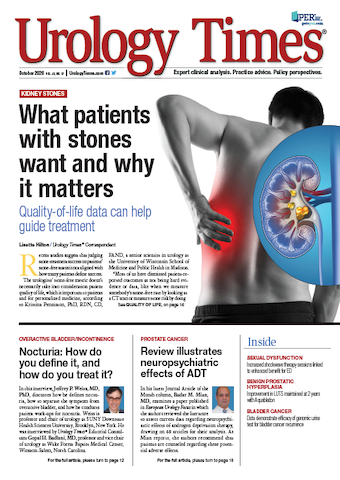Publication
Article
Urology Times Journal
Preoperative bladder symptom score best predictor of transvaginal mesh surgery success
Author(s):
“Although IPSS may not be familiar to gynecologists and urogynecologists, this minimally invasive self-reported questionnaire is useful in counseling preoperative pelvic organ prolapse patients with OAB symptoms," researchers write.
Women with pelvic organ prolapse are more likely to have persistent overactive bladder (OAB) symptoms after transvaginal mesh surgery if they have a high versus low preoperative Overactive Bladder Symptom Score (OABSS) and International Prostate Symptom Score (IPSS).
In a retrospective study of 102 patients who underwent transvaginal mesh surgery by a single surgeon, a preoperative IPSS storage subscore ≥10 was the most useful predictive factor for the persistence of preoperative OAB symptoms after surgery, reported Atsushi Otsuka, from Hamamatsu University, Hamamatsu, Japan, and colleagues in the journal Lower Urinary Tract Symptoms.1
“Interestingly, the present study demonstrated that the preoperative IPSS voiding subscore was also a useful predictive factor for the persistence of preoperative OAB symptoms after surgery although the predictive power did not exceed the preoperative IPSS storage subscore,” the authors wrote. “Although IPSS may not be familiar to gynecologists and urogynecologists, this minimally invasive self-reported questionnaire is useful in counseling preoperative pelvic organ prolapse patients with OAB symptoms.”
The investigators found that among the 54 women in the study with OAB, 20 (37%) had persistent symptoms after surgery, while 34 (63.0%) saw their symptoms disappear.
Among the 20 patients with persistent OAB symptoms postoperatively, 15 had an improvement in their OAB symptoms, while the remaining 5 had unchanged or worsened symptoms.
Total OABSS was significantly higher in patients with persistent preoperative OAB symptoms than in patients without persistent symptoms. On the IPSS, the total score, voiding and storage subscores, and individual component scores were significantly higher in patients with persistent preoperative OAB symptoms than in patients without them.
According to the receiver operating characteristics (ROC) analysis, the area under the curve (AUC) was 0.768 (95% CI, 0.640-0.896; P = .001) for total IPSS; 0.819 (95% CI, 0.694-0.944; P <.001) for IPSS storage subscore; 0.735 (95% CI, 0.596-0.873; P = .004) for IPSS voiding subscore; and 0.693 (95% CI, 0.550-0.835; P =.019) for total OABSS.
The cutoff value for the IPSS storage subscore that indicated nearly equivalent sensitivity and specificity and that retained the greatest efficiency was 9.5.
The sensitivity of the IPSS storage subscore was 68.4% (95% CI, 43.5-87.4), the specificity was 91.2% (95% CI, 76.3-98.1), the positive predictive value was 81.3% (95% CI, 54.4-96.0), and the negative predictive value was 83.8% (95% CI, 68.0-93.8).
The sensitivity and specificity at the of the preoperative IPSS voiding subscore at the cutoff value of 7.5 was 60.0% and 70.6%, respectively.
“In contrast, several preoperative parameters (age, body mass index, parity, pelvic organ prolapse stage) had no significant impact on the persistence of preoperative OAB symptoms,” Otsuka et al wrote.
They continued, “An advantage of the present study is that minimally invasive self-reported questionnaires were used to determine predictive factors for persistence of preoperative OAB symptoms after pelvic organ prolapse surgery. Further, all patients underwent the same surgical procedure using transvaginal mesh by a single surgeon, reducing bias engendered by the type of vaginal surgery.”
Limitations of the research included the retrospective design and the absence of urodynamic study to evaluate detrusor overactivity and bladder outlet obstruction.
The percentages of patients who had relief of symptoms and persistent symptoms postoperatively “are in line with those generally reported for OAB symptom resolution following surgery for significant prolapse,” Alan J. Wein, MD, PhD (hon), co-director of the Voiding Function and Dysfunction Program at Penn Medicine, Philadelphia, wrote in an editorial comment on the research published in the Journal of Urology. “It is generally agreed that parity and body mass index are not predictive for OAB symptoms after prolapse surgery,” added Wein.2
References
1. Otsuka A, Watanabe K, Matsushita Y, et al. Predictive factors for persistence of preoperative overactive bladder symptoms after transvaginal mesh surgery in women with pelvic organ prolapse. Low Urin Tract Symptoms. 2020;12:167-172. doi: 10.1111/luts.12299
2. Wein AJ. Editorial comment. J Urol. 2020;204(3):623-624. doi: 10.1097/JU.0000000000001180


























